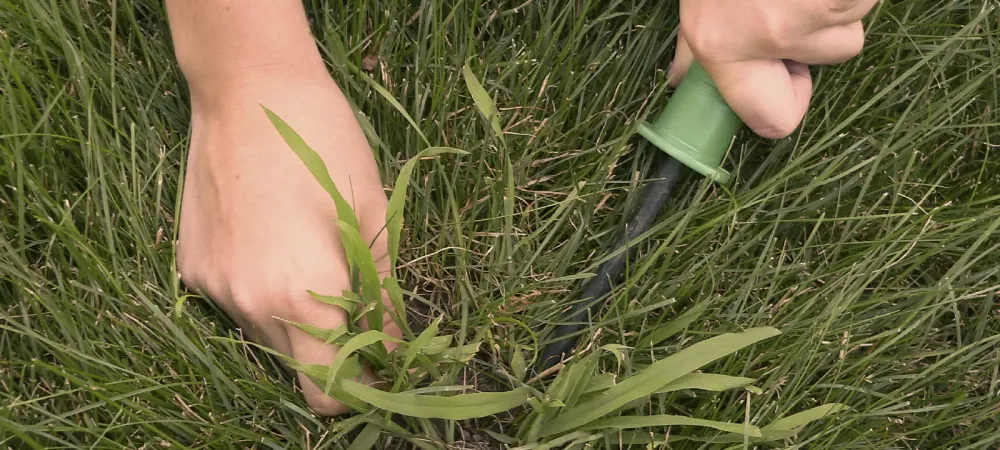Get a Head Start While You Still Can on Crabgrass

As the snow and cold start to fade and spring flowers begin to emerge, so too will weeds start to escape from the ground and grow. And in New Hampshire, one of the most irritating weeds is crabgrass. Even in the best growing conditions, crabgrass can grow out of control. This coarse grass is unappealing looking and is uncomfortable when walking on it.
While crabgrass is actually considered a grass, hence its name, it is not a turf-type grass or typical grass used for lawns. A patch of crabgrass in the middle of an otherwise lovely yard can stick out like a sore thumb! Seeds used for lawns are typically perennials, meaning they come back year after year. Crabgrass, on the other hand, is an annual grass.
When Does Crabgrass First Appear in New Hampshire?
Crabgrass sprouts annually from seeds that were dropped the previous summer and fall. Seeds will start to germinate when your soil has warmed up to at least 55 – 60 degrees for a week. When spring arrives, the timetable can vary here in New Hampshire, but typically we start to see crabgrass in May. That’s why it’s so important to learn everything there is to know about this vexatious, infuriating weed while there is still time to control it.
Why Is Crabgrass Such a Problem?
Crabgrass doesn’t grow upright like other grasses. It grows close to the ground, and the stems extend out like the legs of a crab. This makes it unappealing to most. It’s lighter in color and primarily an opportunistic plant that typically grows in thin or bare areas of your lawn. It can crowd out good grasses that are weakened by bad mowing practices, insects, diseases, or other problems. While crabgrass is a summer annual, they germinate in the spring, grow throughout the summer then die in the winter. During their life cycle, they can produce a vast number of seeds. These seeds can lay dormant in your yard for years, which is why once you have crabgrass, it can be so difficult to control.
Can We Control Crabgrass?
Prevention is Key
First, prevention. Prevention is vital when it comes to crabgrass. This vial weed takes over quickly, almost instantly, stopping new, healthy grass from growing. Pre-emergent crabgrass control kills seedlings as soon as they start to germinate but knowing when germination will occur here in New Hampshire can be difficult to predict. To apply pre-emergent, soil temperatures must be at least in the low 50s. A good rule of thumb is this, if shrubs are in bloom and trees are starting to bud, it’s time to apply pre-emergent.
Wait! If you Have a Newly Seeded Lawn, Read This First
For newly seeded lawns, we suggest that you wait until you have mowed a few times before administering the herbicide to avoid killing the new grass. You also want to be sure that when you use the pre-emergent, you are thorough. Missing even a small patch of crabgrass can result in the rampant spreading of crabgrass throughout the yard. Like with any chemical substance, always read the container carefully before applying.
How To Remove Crabgrass After It has Started Growing
If crabgrass has already started growing in your lawn, using a pre-emergent will no longer work. If you’re feeling feisty, you could physically remove the crabgrass by hand. To do this, use water to loosen up the roots, remove by hand and then water the grass again.
Using a Post-Emergent
There are tons of post-emergent products sold at your local home goods stores labeled as weed killers but the amount and type you should use vary depending upon the type of grass you have. As crabgrass matures, postemergence control becomes more challenging. Multiple applications are needed and must be spaced out two to three weeks apart. And herbicides that kill crabgrass can also kill Kentucky bluegrass, ryegrass, and fescue. So it’s important that if you use a post-emergent, you are careful to make sure you only target the weed itself.
The Best Solution Is To Hire a Professional!
Preventing crabgrass is a year-long chore that requires patience and dedication. To ensure you are only targeting the weed itself and not your grass, and to save time and energy, it’s best to hire a professional. Invest in a company that specializes in weed control and knows the local climate, grass types, and landscape inside and out.
Located in or Around Auburn, New Hampshire? Call Alliance Landscaping
If you are a resident or business located in or around Auburn, New Hampshire, Alliance Landscaping is your solution. We offer broadleaf weed control and weed control for ornamental beds. Even better, our 7-step lawn care program includes weed control within the package. Our broadleaf weed control applications target and eliminate weeds like crabgrass without damaging your lawn and gardens.
At Alliance, we believe that achieving and maintaining a healthy lawn is the best line of defense against crabgrass. That’s why our 7-step lawn care program provides the optimal amount of fertilization to provide your turf with the nutrients it needs to maintain and sustain its health. We want to help. Call 1-603-704-4230, or contact us today, and talk to one of our technicians about how our lawn care service can help you. Learn more about Alliance by following us on Facebook, Twitter, or Instagram.
